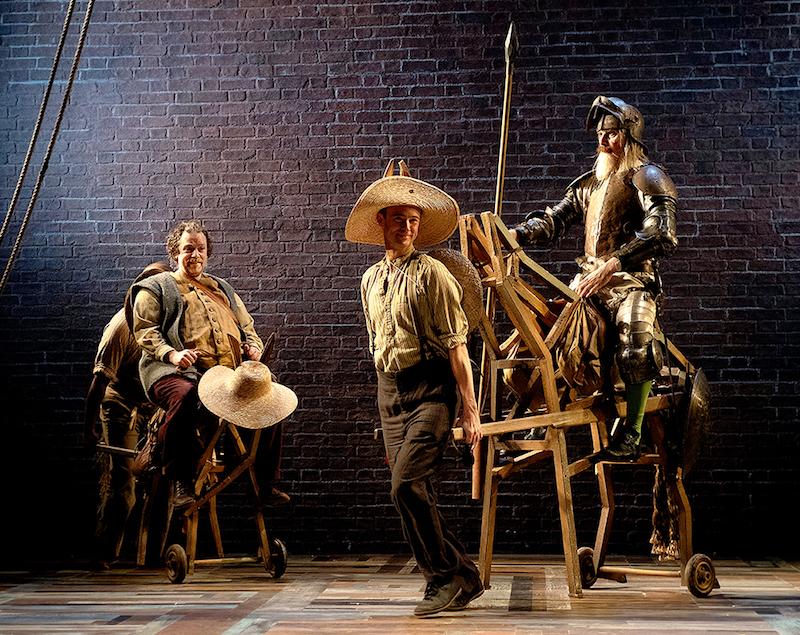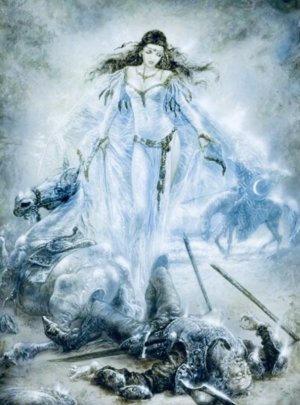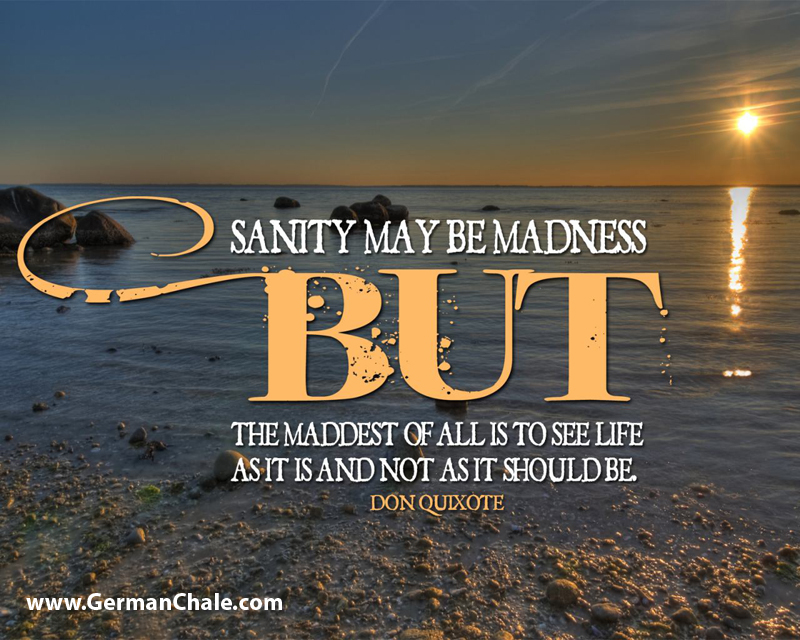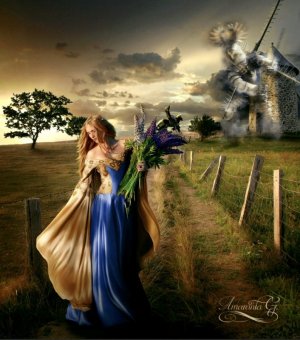You are using an out of date browser. It may not display this or other websites correctly.
You should upgrade or use an alternative browser.
You should upgrade or use an alternative browser.
Don Quixote Update
- Thread starter Meanderer
- Start date
Meanderer
Supreme Member
Don Quixote, Garrick Theatre review - riotous revival

Sanch Panza (Rufus Hound) and Don Quixote (David Threlfall) set off on their adventures
"Don Quixote and his paunchy sidekick long ago escaped the pages of Miguel de Cervantes' novel. The image of the sad-faced knight on his bony nag Rocinante with his companion Sancho Panza atop his donkey are familiar in film, opera, paintings and everything from kitchen tiles to cartoons and furnishing fabric. The knight himself foretold their afterlife, predicting that his exploits would be memorialised in paintings and sculpture. These two - who never existed - may be the most recognisable Spaniards of all time."

Sanch Panza (Rufus Hound) and Don Quixote (David Threlfall) set off on their adventures
"Don Quixote and his paunchy sidekick long ago escaped the pages of Miguel de Cervantes' novel. The image of the sad-faced knight on his bony nag Rocinante with his companion Sancho Panza atop his donkey are familiar in film, opera, paintings and everything from kitchen tiles to cartoons and furnishing fabric. The knight himself foretold their afterlife, predicting that his exploits would be memorialised in paintings and sculpture. These two - who never existed - may be the most recognisable Spaniards of all time."
RadishRose
SF VIP
- Location
- Connecticut, USA
I watched this strange film made by Orson Wells. It may be interesting saved for a time "when there's nothing good on".
Don Quixote is an unfinished film project produced, written and directed by Orson Welles. Principal photography took place between 1957 and 1969. Test footage was filmed as early as 1955, second-unit photography was done as late as 1972, and Welles was working on the film intermittently until his death in 1985. The film was eventually edited by Jesús Franco and was released in 1992. It did not include all the footage shot for the film and received mixed reviews.
Don Quixote is an unfinished film project produced, written and directed by Orson Welles. Principal photography took place between 1957 and 1969. Test footage was filmed as early as 1955, second-unit photography was done as late as 1972, and Welles was working on the film intermittently until his death in 1985. The film was eventually edited by Jesús Franco and was released in 1992. It did not include all the footage shot for the film and received mixed reviews.
Meanderer
Supreme Member
Thanks RR, I did read about that but didn't find the video. Might be fun to watch!I watched this strange film made by Orson Wells. It may be interesting saved for a time "when there's nothing good on".
Don Quixote is an unfinished film project produced, written and directed by Orson Welles. Principal photography took place between 1957 and 1969. Test footage was filmed as early as 1955, second-unit photography was done as late as 1972, and Welles was working on the film intermittently until his death in 1985. The film was eventually edited by Jesús Franco and was released in 1992. It did not include all the footage shot for the film and received mixed reviews.
RadishRose
SF VIP
- Location
- Connecticut, USA
My son and DIL's photo of Niagra when they went to Canada last week.

hmmm... ? .... did he ever lose to a windmill ?Windmill: 1....Don: 0
Is that associated with one of his quotes I heard, most famous I like ----
"Reason", i.e. man's 'reason', is man's greatest enemy.
Old_Dame
Member
- Location
- California

“Hail, white-armed goddess, bright Selene, mild, bright-tressed queen!
And now I will leave you and sing the glories of men half-divine, whose deeds minstrels, the servants of the Muses, celebrate with lovely lips.”
This interpretation, illustration, is rather refreshing from the norm; as it deviates from the typical portrayal of women’s role in Don Quixote.
Cervantes exposes the raw truth of disparity between the sexes as being “less” than romantic; noting that men either lusted after, or deemed them as lowly chattel, and mere ornaments in need of rescue, which instituted a subjugated, inferior bias of the fairer sex.
Meanderer
Supreme Member
Old_Dame
Member
- Location
- California
“The quixotic world of women covers a broad spectrum of the society of his time that includes peasants, princesses, prostitutes, shepherdesses, duchesses, men disguised as women, serving wenches or landladies with beards.”
“The women who did have power, through their connections with a man of power were still limited. Their unique traits and ideals are what made them strong female characters, that did not become imprisoned to the standards society has set for them.
Even so, they still remain in a society of men that render them nearly powerless.”
The quixotic women are intelligent; they proved themselves supremely adaptable, transcending deep-rooted rigidity amidst male-driven society, in an unglamorous world forced upon them, and not of their making.
Which Cervantes beautifully conveys throughout his two novels.
“What is the main message of Don Quixote?
Considered a founding work of modern Western literature, the novels message that individuals can be right while society is wrong was considered radical for its day…”
“The women who did have power, through their connections with a man of power were still limited. Their unique traits and ideals are what made them strong female characters, that did not become imprisoned to the standards society has set for them.
Even so, they still remain in a society of men that render them nearly powerless.”
The quixotic women are intelligent; they proved themselves supremely adaptable, transcending deep-rooted rigidity amidst male-driven society, in an unglamorous world forced upon them, and not of their making.
Which Cervantes beautifully conveys throughout his two novels.
“What is the main message of Don Quixote?
Considered a founding work of modern Western literature, the novels message that individuals can be right while society is wrong was considered radical for its day…”
Meanderer
Supreme Member
"A sneak-peak into the rehearsals for Don Quixote with the company. Artistic Director Iain MacDonald and Ballet Mistress Lauren Slade discuss their roles in putting the production together. We also hear from dancers Tumi Lekana who plays Creado, the mischievous street boy as well as Ana Paulino who dances the role of the cupid Amour."
Don Quixote 2020 - Rehearsals
Don Quixote 2020 - Rehearsals
Old_Dame
Member
- Location
- California
Old_Dame
Member
- Location
- California
PARABLE OF CERVANTES
AND THE QUIXOTE
Tired of his Spanish land, an old soldier of the king sought solace in the vast geographies of Ariosto, in that valley of the moon where the time wasted by dreams is contained and in the golden idol of Mohammed stolen by Montalbán.
In gentle mockery of himself, he imagined a credulous man who, perturbed by his reading of marvels, decided to seek prowess and enchantment in prosaic places called El Toboso or Montiel.
Vanquished by reality, by Spain, Don Quixote died in his native village in the year 1614. He was survived but a short time by Miguel de Cervantes.
For both of them, for the dreamer and the dreamed one, the whole scheme of the work consisted in the opposition of two worlds: the unreal world of the e books of chivalry, the ordinary everyday world of the seventeenth century.
They did not suspect that the years would finally smooth away that discord, they did not suspect that La Mancha and Montiel and the knight's lean figure would be, for posterity, no less poetic than the episodes of Sinbad or the vast geographies of Ariosto.
For in the beginning of literature is the myth, and in the end as well.
-JORGES BORGES
Translated by James E. Irby
Labyrinths (1960)
AND THE QUIXOTE
Tired of his Spanish land, an old soldier of the king sought solace in the vast geographies of Ariosto, in that valley of the moon where the time wasted by dreams is contained and in the golden idol of Mohammed stolen by Montalbán.
In gentle mockery of himself, he imagined a credulous man who, perturbed by his reading of marvels, decided to seek prowess and enchantment in prosaic places called El Toboso or Montiel.
Vanquished by reality, by Spain, Don Quixote died in his native village in the year 1614. He was survived but a short time by Miguel de Cervantes.
For both of them, for the dreamer and the dreamed one, the whole scheme of the work consisted in the opposition of two worlds: the unreal world of the e books of chivalry, the ordinary everyday world of the seventeenth century.
They did not suspect that the years would finally smooth away that discord, they did not suspect that La Mancha and Montiel and the knight's lean figure would be, for posterity, no less poetic than the episodes of Sinbad or the vast geographies of Ariosto.
For in the beginning of literature is the myth, and in the end as well.
-JORGES BORGES
Translated by James E. Irby
Labyrinths (1960)















